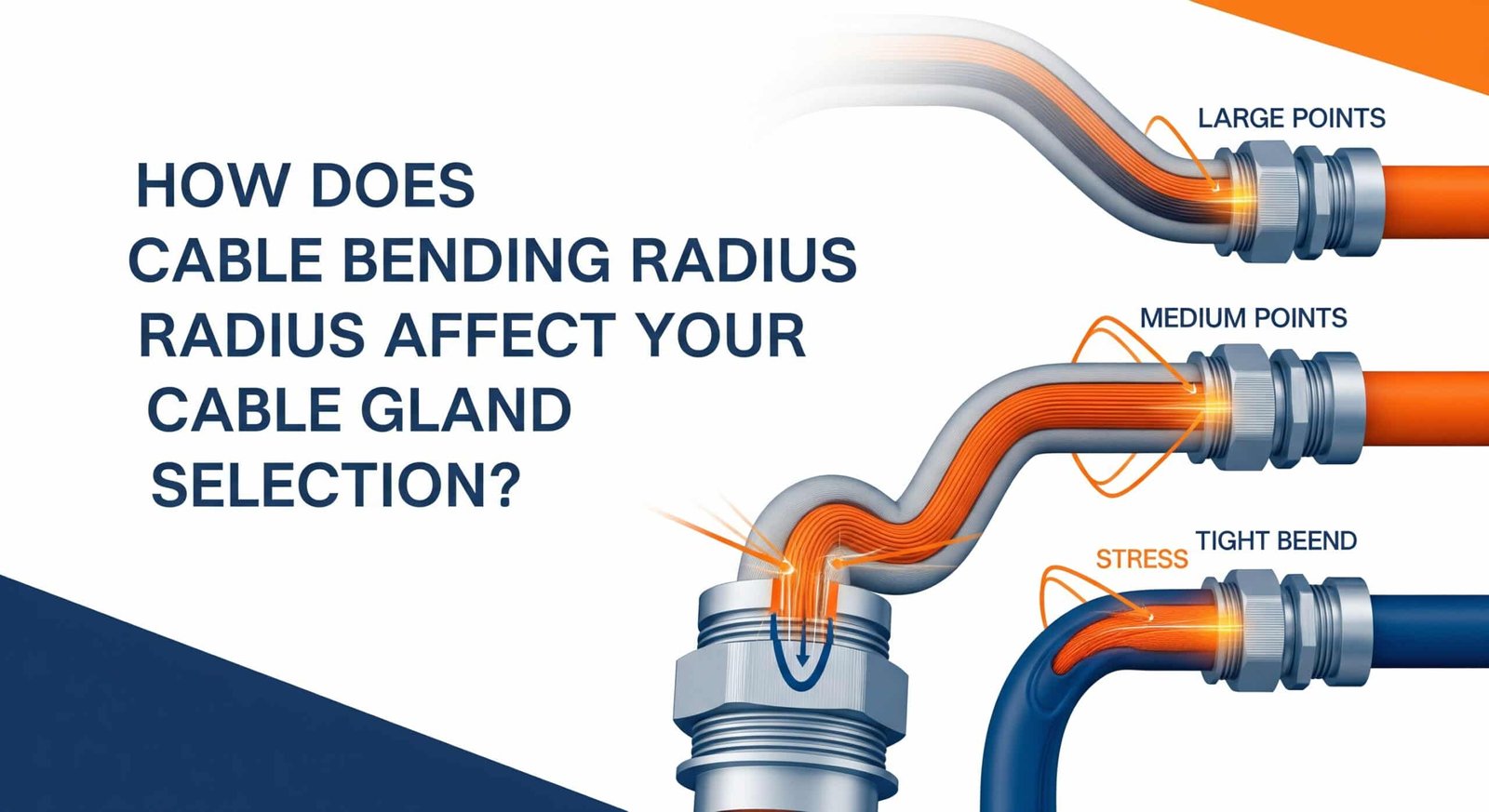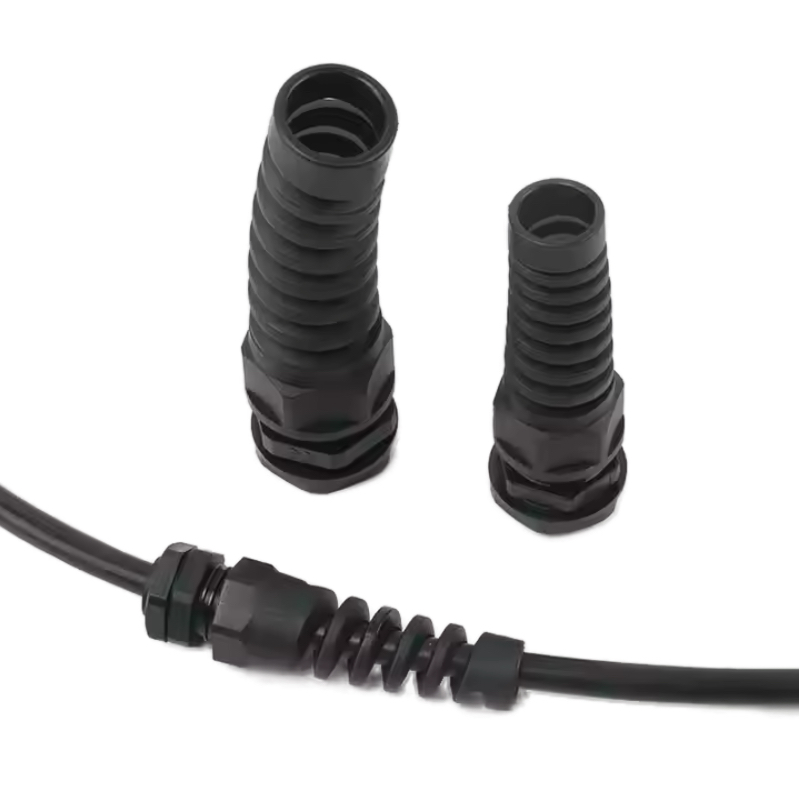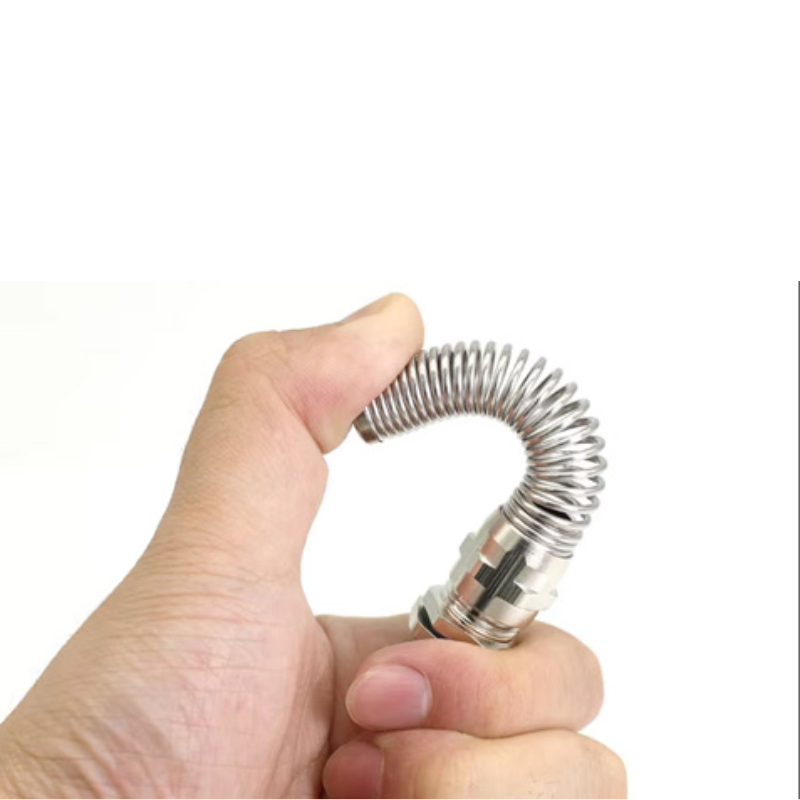Virheellinen kaapelin taivutus aiheuttaa jännityskeskittymiä, jotka vaurioittavat johtimia, heikentävät eristyksen eheyttä ja aiheuttavat ennenaikaisia kaapelin vikoja, kun taas riittämättömät taivutussäteen laskelmat johtavat asennusongelmiin, kaapelin lyhentyneeseen käyttöikään ja turvallisuusriskeihin, jotka voivat johtaa järjestelmän käyttökatkoksiin ja kalliisiin korjauksiin. Monet asentajat aliarvioivat kaapelin taivutussäteen ja kaapeliläpiviennin valinnan välisen kriittisen suhteen, mikä johtaa asennuksiin, jotka näyttävät oikeilta mutta vikaantuvat ennenaikaisesti mekaanisen rasituksen ja vedonpoiston riittämättömyyden vuoksi.
Kaapelin taivutussäde vaikuttaa suoraan kaapeliläpivientien valintaan, sillä se määrittää minimitaivutusvaatimukset, vedonpoistotarpeet ja asennustilavaatimukset. Oikea valinta edellyttää kaapelin rakenteen, ympäristöolosuhteiden ja mekaanisten rasitustekijöiden tuntemusta, jotta voidaan varmistaa luotettava pitkäaikainen suorituskyky ja estää kaapelin vaurioituminen asennuksen ja käytön aikana. Taivutussäteen ja läpivientien suunnittelun välinen suhde on olennainen tekijä onnistuneissa kaapelinhallintajärjestelmissä.
Työskenneltyäni sähköurakoitsijoiden kanssa suurissa autoteollisuuden tehtaissa Detroitissa, datakeskuksissa Frankfurtissa ja petrokemian laitoksissa kaikkialla Lähi-idässä olen nähnyt, miten kaapelin taivutussäteen ymmärtäminen voi estää kalliita asennusvirheitä ja varmistaa järjestelmän luotettavan toiminnan. Salli minun jakaa olennainen tieto kaapeliläpivientien valitsemiseksi siten, että ne vastaavat asianmukaisesti kaapeleiden taivutussäteitä koskevia vaatimuksia.
Sisällysluettelo
- Mikä on kaapelin taivutussäde ja miksi sillä on merkitystä?
- Miten lasketaan minimitaivutussäde eri kaapelityypeille?
- Mitkä kaapeliläpivientien ominaisuudet tukevat asianmukaista taivutussäteen hallintaa?
- Miten ympäristötekijät vaikuttavat taivutussäteen vaatimuksiin?
- Mitkä ovat parhaat käytännöt asennusta ja pitkäaikaista suorituskykyä varten?
- Usein kysytyt kysymykset kaapelin taivutussäteestä
Mikä on kaapelin taivutussäde ja miksi sillä on merkitystä?
Kaapelin taivutussäde1 on pienin säde, jolla kaapelia voidaan taivuttaa ilman, että sen sisäinen rakenne vahingoittuu, mikä vaikuttaa johtimen eheyteen, eristyksen suorituskykyyn ja kaapelin yleiseen käyttöikään, joten se on kriittinen tekijä kaapeliläpivientien valinnassa, koska riittämätön taivutussäteen tuki johtaa jännityskeskittymiin, ennenaikaisiin vioittumisiin ja turvallisuusriskiin sähköasennuksissa.
Taivutussäteen perusteiden ymmärtäminen on olennaista, koska jopa korkealaatuiset kaapelit ja läpiviennit epäonnistuvat, jos mekaanisia perusperiaatteita ei noudateta suunnittelussa ja asennuksessa.
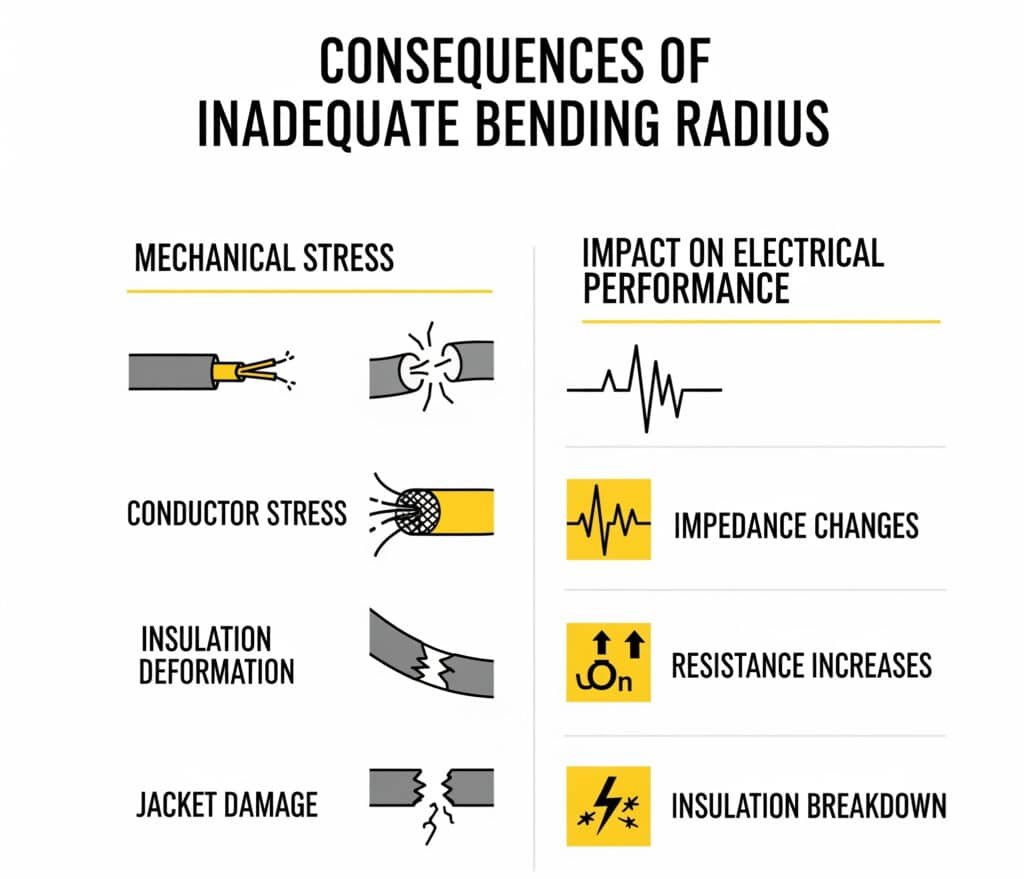
Mekaanisen rasituksen perusteet
Johtimen jännitys: Kun kaapelit taipuvat, ulkojohtimiin kohdistuu vetojännitystä ja sisäjohtimiin puristusvoimia, jolloin liiallinen taipuminen aiheuttaa johtimen katkeamisen, työkovettuminen2ja lopulta epäonnistuminen.
Eristeen muodonmuutos: Kaapelin eristys venyy ulkosäteellä ja puristuu sisäsäteellä taivutuksen aikana, jolloin tiukat taivutukset aiheuttavat pysyviä muodonmuutoksia, halkeilua ja heikentävät kestävyyttä. dielektrinen lujuus3.
Suojauksen eheys: Kaapeleiden suojausjärjestelmiin kohdistuu taivutuksen aikana eriäviä rasituksia, jotka voivat aiheuttaa suojauksen epäjatkuvuuskohtia, jotka heikentävät EMC-suorituskykyä ja aiheuttavat turvallisuusriskejä.
Takki vaurioitunut: Kaapelin ulkovaippaan kohdistuu taivutuksen aikana suurin rasitus, ja riittämätön säde aiheuttaa pinnan halkeilua, ympäristötiiviyden häviämistä ja nopeutettua vanhenemista.
Vaikutus sähköiseen suorituskykyyn
Impedanssin muutokset: Tiukat mutkat muuttavat kaapelin geometriaa ja johtimien välejä, mikä aiheuttaa impedanssimuutoksia, jotka vaikuttavat signaalin eheyteen data- ja tietoliikennekaapeleissa.
Kapasitanssin vaihtelut: Taivutus muuttaa johtimien ja maatasojen välistä suhdetta, mikä aiheuttaa kapasitanssin vaihtelua, joka voi aiheuttaa signaalin heijastuksia ja ajoitusongelmia.
Vastustuskyky kasvaa: Liiallisesta taivutuksesta johtuva johtimen muodonmuutos lisää sähkövastusta, mikä aiheuttaa jännitteen alenemista, tehohäviöitä ja lämmönmuodostusta.
Eristyksen hajoaminen: Jännittyneen eristyksen läpilyöntijännite on pienentynyt ja vuotovirta kasvanut, mikä aiheuttaa turvallisuusriskejä ja luotettavuusongelmia.
Pitkän aikavälin luotettavuusvaikutukset
Väsymisvika: Toistuva taivuttaminen riittämättömällä taivutussäteellä aiheuttaa johtimissa ja eristyksessä väsymisvaurioita, jotka johtavat ajoittaisiin vikoihin ja lopulta täydelliseen vikaantumiseen.
Ympäristöön tunkeutuminen: Vääränlaisesta taivutuksesta johtuvat vaippavauriot päästävät kosteutta ja epäpuhtauksia kaapeleihin, mikä kiihdyttää eristyksen hajoamista ja korroosiota.
Lämpökysymykset: Taivutettujen johtimien lisääntynyt vastus aiheuttaa paikallista kuumenemista, mikä nopeuttaa eristyksen vanhenemista ja saattaa aiheuttaa palovaaran.
Huolto-ongelmat: Riittämättömällä taivutussäteellä asennettuja kaapeleita on vaikea huoltaa, ja ne on usein vaihdettava kokonaan korjaamisen sijaan.
Saksan Stuttgartissa sijaitsevan merkittävän autonvalmistajan hankintapäällikkö David kohtasi toistuvia kaapelivikoja robottihitsausjärjestelmissä, joissa kaapelien reititys oli tilanpuutteen vuoksi tiukkaa. Hänen huoltotiiminsä vaihtoi kaapelit 8-12 kuukauden välein johtimien rikkoutumisen ja taivutuskohdissa olevien eristysvikojen vuoksi. Analysoimme asennuksen ja havaitsimme, että kaapelit taivutettiin puoleen niiden vähimmäissäteestä. Valitsemalla suorakulmaiset kaapeliläpiviennit ja suunnittelemalla kaapelin reititys uudelleen siten, että taivutussäde tukee oikeaa taivutussädettä, pidensimme kaapeleiden käyttöikää yli kolmeen vuoteen ja poistimme 90% kaapeleihin liittyvää seisokkiaikaa. Alkuperäinen investointi oikeisiin kaapeliläpivientiin maksoi itsensä takaisin kuudessa kuukaudessa pienentyneiden ylläpitokustannusten ansiosta. 😊
Miten lasketaan minimitaivutussäde eri kaapelityypeille?
Minimitaivutussäteen laskeminen edellyttää kaapelin rakenteen, johdinmateriaalien, eristetyyppien ja sovellusvaatimusten ymmärtämistä, ja vakiolaskelmat perustuvat kaapelin ulkohalkaisijaan kerrottuna rakennekohtaisilla kertoimilla, jotka vaihtelevat joustavien kaapeleiden 4-kertaisesta jäykkien rakenteiden 15-kertaiseen, ja samalla otetaan huomioon dynaamiset ja staattiset taivutusvaatimukset ja ympäristöolosuhteet.
Asianmukainen laskenta on ratkaisevan tärkeää, koska yleisten nyrkkisääntöjen käyttö voi johtaa joko liian varovaisiin suunnitelmiin, joissa tuhlataan tilaa, tai alimitoitettuihin asennuksiin, jotka aiheuttavat ennenaikaisia vikoja.
Vakiolaskentamenetelmät
Peruskaava: Pienin taivutussäde = kaapelin ulkohalkaisija × kerroin, jossa kerroin riippuu kaapelin rakenteesta, johtimen tyypistä ja sovellusvaatimuksista.
Staattinen vs. dynaaminen taivutus: Staattisissa asennuksissa (pysyvät taivutukset) sallitaan yleensä pienempi säde kuin dynaamisissa sovelluksissa (toistuva taivutus), ja dynaamisissa sovelluksissa tarvitaan 2-3 kertaa suurempi säde.
Asennus vs. toimintasäde: Asennuksen aikana tapahtuva tilapäinen taivutus voi sallia pienemmän säteen kuin pysyvissä käyttöolosuhteissa, mutta asennusjännitystä on silti valvottava vaurioiden välttämiseksi.
Lämpötilaa koskevat näkökohdat: Kylmät lämpötilat lisäävät kaapelin jäykkyyttä ja vaativat suuremman taivutussäteen, kun taas korkeat lämpötilat voivat pehmentää eristystä ja sallia pienemmän säteen asianmukaisella tuella.
Kaapelityyppikohtaiset vaatimukset
Voimakaapelit (600V-35kV):
- Yksi johdin: 8-12 kertaa ulkohalkaisija
- Monijohdin: 6-10 kertaa ulkohalkaisija
- Vankka kaapelit: 12-15 kertaa ulkohalkaisija
- Korkea jännite: 15-20 kertaa ulkohalkaisija
Ohjaus- ja instrumentointikaapelit:
- Joustava ohjaus: 4-6 kertaa ulkohalkaisija
- Suojatut parit: 6-8 kertaa ulkohalkaisija
- Monipariset tiedot: 4-6 kertaa ulkohalkaisija
- Termopari: 5-7 kertaa ulkohalkaisija
Viestintäkaapelit:
- Ethernet/Cat6: 4-6 kertaa ulkohalkaisija
- Koaksiaalinen: 5-7 kertaa ulkohalkaisija
- Kuituoptinen4: 10-20 kertaa ulkohalkaisija
- Hyllykaapeli: 6-8 kertaa ulkohalkaisija
Erikoissovellukset:
- Merikaapelit: 8-12 kertaa ulkohalkaisija
- Kaivoskaapelit: 10-15 kertaa ulkohalkaisija
- Robottikaapelit: 3-5 kertaa ulkohalkaisija
- Solar DC -kaapelit: 5-8 kertaa ulkohalkaisija
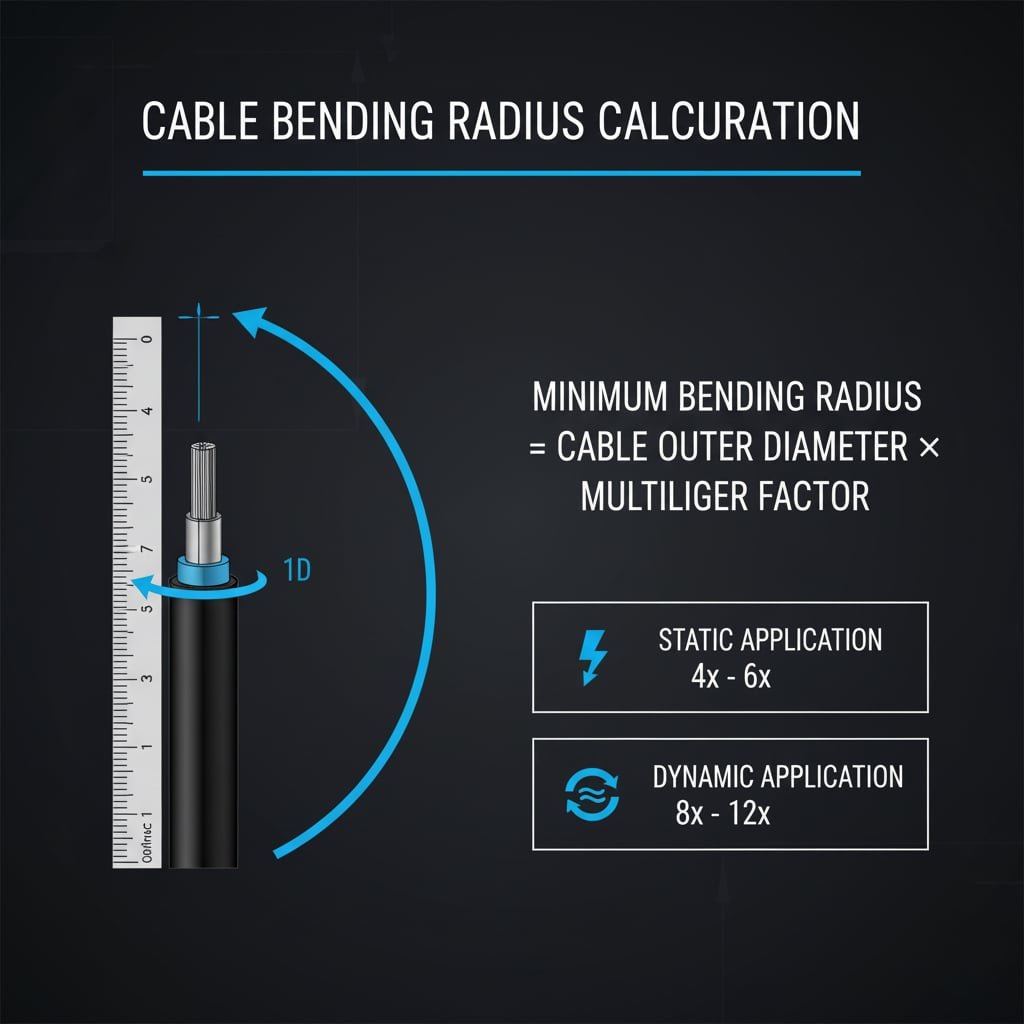
Ympäristö- ja sovellustekijät
Lämpötilan vaikutukset: Alhaiset lämpötilat lisäävät kaapelin jäykkyyttä, mikä edellyttää suurempaa taivutussädettä, kun taas valmistajan määrityksissä oletetaan yleensä 20 °C:n (68 °F) ympäristöolosuhteet.
Tärinä ja liike: Sovellukset, joissa esiintyy tärinää tai toistuvia liikkeitä, vaativat suuremman taivutussäteen väsymisvikaantumisen estämiseksi ja pitkäaikaisen luotettavuuden säilyttämiseksi.
Kemiallinen altistuminen: Aggressiiviset kemikaalit voivat pehmentää tai kovettaa kaapelin vaippoja, mikä vaikuttaa joustavuuteen ja edellyttää taivutussäteen laskelmien mukauttamista.
UV- ja sääaltistus: Ulkoasennuksissa vaippa voi kovettua UV-altistumisen vuoksi, jolloin taivutussäde voi ajan myötä kasvaa.
Laskentaesimerkki Taulukko
| Kaapelityyppi | Halkaisija | Staattinen kerroin | Dynaaminen kerroin | Min. Säde (staattinen) | Min. Säde (dynaaminen) |
|---|---|---|---|---|---|
| 12 AWG THWN | 6mm | 6x | 10x | 36mm (1.4″) | 60mm (2.4″) |
| 4/0 AWG Virta | 25mm | 8x | 12x | 200mm (7.9″) | 300mm (11.8″) |
| Cat6 Ethernet | 6mm | 4x | 8x | 24mm (0.9″) | 48mm (1.9″) |
| RG-6 koaksiaali | 7mm | 5x | 10x | 35mm (1.4″) | 70mm (2.8″) |
| 2/0 panssaroitu | 35mm | 12x | 18x | 420mm (16.5″) | 630mm (24.8″) |
Mitkä kaapeliläpivientien ominaisuudet tukevat asianmukaista taivutussäteen hallintaa?
Oikeaa taivutussädettä tukeviin kaapeliläpivienneihin kuuluu suorakulmaisia malleja, laajennettuja vedonpoistojärjestelmiä, joustavia putkiliitäntöjä ja säädettäviä tulokulmia, jotka mukautuvat asennusrajoituksiin säilyttäen kuitenkin minimitaivutusvaatimukset, ja erityisominaisuuksilla, kuten taivutusrajoittimilla, kaapelinohjaimilla ja monisuuntaisilla tulokulmilla, tarjotaan optimaalinen kaapelisuojaus.
On erittäin tärkeää valita sopivalla taivutussäteellä varustetut läpiviennit, sillä asianmukaiset laskelmat ovat hyödyttömiä, jos kaapeliläpivientien suunnittelu pakottaa kaapelit tiukkaan mutkaan liitoskohdassa.
Oikean kulman kaapeliläpiviennit
90 asteen sisäänkäynnit: Esimuotoillut suorakulmaiset liitännät poistavat terävät mutkat liitäntäkohdasta, mikä mahdollistaa kaapelin pehmeän siirtymisen, joka säilyttää oikean taivutussäteen koko liitännän ajan.
45 asteen sisäänkäynnit: Kulmaiset sisäänmenot tarjoavat kompromissin tilansäästön ja taivutussäteen vaatimusten välillä, ja ne soveltuvat sovelluksiin, joissa on kohtalaisia tilarajoitteita.
Muuttuvan kulman mallit: Säädettävät tulokulmat mahdollistavat optimoinnin erityisten asennusvaatimusten mukaan, mikä tarjoaa joustavuutta säilyttäen samalla asianmukaisen kaapelituen.
Integroitu taivutustuki: Sisäiset säteittäiset tuet muhvin rungossa varmistavat, että kaapelit säilyttävät oikean kaarevuuden myös mekaanisen rasituksen tai lämpösyklien aikana.
Jännevapautus- ja kaapelitukijärjestelmät
Laajennettu rasitusvapautus: Pidemmät vedonpoisto-osuudet jakavat taivutusjännityksen suuremmalle kaapelin pituudelle, mikä vähentää jännityskeskittymiä ja parantaa pitkän aikavälin luotettavuutta.
Progressiivinen jäykkyys: Jäykkyysasteikolla varustetut rasitusvapautusjärjestelmät mahdollistavat pehmeän siirtymisen jäykästä liitäntärungosta joustavaan kaapeliin ja estävät jännityskeskittymien syntymisen.
Monipistetuki: Useat tukipisteet venytyksenpoistopituuden varrella varmistavat jännityksen tasaisen jakautumisen ja estävät kaapelin taittumisen kuormituksen alla.
Irrotettava rasitusvapautus: Vaihdettavat vedonpoistokomponentit mahdollistavat kunnossapidon ja päivittämisen ilman täydellistä liitännän vaihtoa, mikä vähentää pitkän aikavälin kustannuksia.
Joustavat liitäntäjärjestelmät
Nestetiiviit liittimet: Joustavat metalli- tai polymeeriputkiyhteet tarjoavat erinomaisen taivutussäteen mukautumisen säilyttäen samalla ympäristötiiviyden.
Bellows Connections: Harmonikkatyyliset joustavat liitokset vaimentavat liikettä ja tärinää säilyttäen samalla kaapelin taivutussäteen ja ympäristönsuojelun.
Universal Joint Designs: Nivelletyt liitokset mahdollistavat monisuuntaisen liikkeen ja tukevat samalla kaapelin oikeaa taivutusta koko liikealueella.
Jousitetut järjestelmät: Jousimekanismit ylläpitävät kaapeleiden jatkuvaa tukipainetta lämpölaajenemisen ja mekaanisen liikkeen aikana.
Tilaa säästävät ratkaisut
Kompaktit suorakulmaiset mallit: Miniatyrisoidut suorakulmaiset läpiviennit tukevat taivutussädettä sopivalla tavalla tilanpuutteellisissa sovelluksissa, kuten ohjauspaneeleissa ja kytkentärasioissa.
Pinottavat kokoonpanot: Useita kaapeliläpivientejä kompaktissa järjestelyssä, joka säilyttää yksittäisten kaapeleiden taivutussäteitä koskevat vaatimukset.
Integroitu kaapelinhallinta: Sisäänrakennetut kaapelin reititysominaisuudet, jotka ohjaavat kaapelit oikean taivutussäteen reittien kautta läpivientikokoonpanon sisällä.
Modulaariset järjestelmät: Konfiguroitavat liitosjärjestelmät, jotka voidaan mukauttaa tiettyyn taivutussäteeseen ja tilavaatimuksiin.
Valintaperusteiden matriisi
| Sovellustyyppi | Suositellut rauhasominaisuudet | Taivutussäde Hyöty | Tyypilliset sovellukset |
|---|---|---|---|
| Ohjauspaneelit | Suorakulmainen, kompakti muotoilu | Säästää tilaa 60-80% | Teollinen automaatio |
| Ulkokotelot | Laajennettu vedonpoisto | Vähentää stressiä 50% | Sääasemat |
| Tärinäympäristöt | Joustavat liitännät | Ehkäisee väsymysvikaantumista | Liikkuvat laitteet |
| Suuren tiheyden asennukset | Pinottava, monikäyttöinen | Optimoi kaapelin reitityksen | Tietokeskukset |
| Huolto Pääsy | Irrotettava vedonpoisto | Ottaa palvelun käyttöön | Prosessilaitteet |
Jubailissa Saudi-Arabiassa sijaitsevaa petrokemian laitosta johtavan Hassanin oli päivitettävä ohjausjärjestelmän kaapelointi nykyisissä valvomoissa, joissa kaapeleiden asianmukainen taivutussäde oli tilanpuutteen vuoksi lähes mahdoton tavallisilla kaapeliläpivienneillä. Alkuperäisessä asennuksessa käytettiin suoria läpivientejä, jotka pakottivat kaapelit ahtaisiin 90 asteen mutkiin heti paneelin sisääntulon kohdalla, mikä aiheutti usein kaapelivikoja ja huolto-ongelmia. Toimitimme kompaktit suorakulmaiset kaapeliläpiviennit, joissa oli integroitu vedonpoisto, joka säilytti oikean taivutussäteen ja vähensi samalla 70%:n vaatimaa paneelitilaa. Asennus poisti kaapeleiden jännityskohdat ja vähensi kaapeleihin liittyviä huoltokutsuja 85%:llä, ja parannettu kaapelinhallinta paransi myös valvomon ammattimaista ulkonäköä.
Miten ympäristötekijät vaikuttavat taivutussäteen vaatimuksiin?
Ympäristötekijät vaikuttavat merkittävästi taivutussäteen vaatimuksiin, koska lämpötila vaikuttaa kaapelin joustavuuteen, kemiallinen altistuminen vaikuttaa vaipan ominaisuuksiin, UV-säteily muuttaa materiaalin ominaisuuksia ja tärinästä ja liikkeistä johtuvat mekaaniset rasitukset edellyttävät suurempia varmuusmarginaaleja taivutussäteen laskennassa luotettavan pitkäaikaisen suorituskyvyn varmistamiseksi.
Ympäristövaikutusten ymmärtäminen on ratkaisevan tärkeää, koska kaapeleiden ja läpivientien tekniset tiedot perustuvat yleensä laboratorio-olosuhteisiin, jotka eivät välttämättä vastaa todellisia asennusolosuhteita.
Lämpötilan vaikutus kaapelin joustavuuteen
Matalan lämpötilan vaikutus: Kylmät lämpötilat lisäävät kaapelin jäykkyyttä huomattavasti, sillä jotkut kaapelit ovat 3-5 kertaa jäykempiä -40 °C:ssa kuin huoneenlämmössä, mikä edellyttää suhteellisesti suurempaa taivutussädettä.
Korkean lämpötilan vaikutukset: Kohonneet lämpötilat pehmentävät kaapelin vaippaa ja eristystä, mikä saattaa mahdollistaa pienemmän taivutussäteen, mutta vähentää myös mekaanista lujuutta ja lisää muodonmuutosriskiä.
Lämpösyklinen rasitus: Toistuvat lämpötilamuutokset aiheuttavat laajenemista ja supistumista, mikä aiheuttaa lisäjännitystä taivutuskohtiin, mikä edellyttää suurempia varmuusmarginaaleja taivutussäteen laskennassa.
Asennuslämpötila: Kylmiin olosuhteisiin asennetut kaapelit voivat halkeilla tai vaurioitua, jos ne taivutetaan lämpimän sään vaatimusten mukaisesti, jolloin tarvitaan lämpötilan mukaan mukautettuja asennusmenetelmiä.
Kemiallinen ja ympäristöaltistus
Kemiallinen pehmennys: Jotkin kemikaalit pehmentävät kaapelin vaippaa, mikä vähentää mekaanista lujuutta ja edellyttää suurempaa taivutussädettä pysyvän muodonmuutoksen estämiseksi.
Kemiallinen kovettuminen: Muut kemikaalit aiheuttavat vaipan kovettumista, joka lisää jäykkyyttä ja vaatii alkuperäisiä vaatimuksia suuremman taivutussäteen.
Otsoni ja UV-altistuminen: Ulkoasennuksissa vaippa heikkenee, mikä muuttaa joustavuusominaisuuksia ajan myötä, mikä edellyttää taivutuskyvyn säännöllistä uudelleenarviointia.
Kosteusvaikutukset: Veden imeytyminen voi muuttaa kaapelin vaipan ominaisuuksia, mikä vaikuttaa joustavuuteen ja edellyttää mukautettuja taivutussäteilylaskelmia märissä ympäristöissä.
Mekaanista rasitusta koskevat näkökohdat
Tärinäympäristöt: Jatkuva tärinä aiheuttaa väsymisrasitusta, joka vaatii suurempaa taivutussädettä ennenaikaisen vikaantumisen estämiseksi, tyypillisesti 1,5-2 kertaa staattiset vaatimukset.
Dynaaminen liike: Sovelluksissa, joissa kaapeli liikkuu säännöllisesti, tarvitaan huomattavasti suurempi taivutussäde, jotta toistuva taipuminen onnistuu ilman väsymisvaurioita.
Asennusrasitus: On otettava huomioon kaapelin vedon ja reitityksen aikaiset tilapäiset asennusrasitukset, jotka usein edellyttävät asennuksen aikana suurempaa sädettä kuin lopullisissa käyttöolosuhteissa.
Tukijärjestelmän vaikutukset: Kaapelihyllyjärjestelmät, putkistot ja muut tukirakenteet vaikuttavat taivutusjännityksen jakautumiseen ja saattavat vaatia mukautettuja sädelaskelmia.
Ympäristön mukauttamistekijät
Lämpötilan säätötaulukko:
- -40°C - -20°C: 2,0-2,5.
- -20°C - 0°C: Kerro vakiosäde 1,5-2,0:lla.
- 0°C - 20°C: Käytä vakiosäteitä
- 20°C - 60°C: voi pienentää sädettä 10-20%:llä asianmukaisella tuella.
- Yli 60 °C: Vaatii erityisiä korkean lämpötilan laskelmia
Kemiallisen altistuksen mukautukset:
- Lievä kemiallinen altistuminen: Lisää 20-30% turvamarginaali
- Kohtalainen altistuminen: Lisää 50-75% turvamarginaali
- Vakava altistuminen: Vaatii erikoistuneita kaapeli- ja läpivientimateriaaleja
- Tuntemattomat kemikaalit: Käytä enimmäisturvamarginaaleja, kunnes testaus vahvistaa yhteensopivuuden.
Tärinä- ja liikesäädöt:
- Vähäinen tärinä (< 2 g): Lisää 25%-turvamarginaali
- Kohtalainen tärinä (2-5 g): Lisää 50%-turvamarginaali
- Voimakas tärinä (> 5 g): Lisää 100% turvamarginaali
- Jatkuva taivutus: Käytä dynaamisia taivutuseritelmiä
Pitkän aikavälin suorituskykyä koskevat näkökohdat
Ikääntymisen vaikutukset: Kaapelivaipat jäykistyvät iän myötä, mikä edellyttää suurempaa taivutussädettä ajan myötä tai suunniteltua vaihtoaikataulua.
Huolto pääsy: Ympäristöolosuhteet voivat rajoittaa huoltoon pääsyä, jolloin tarvitaan varovaisempia taivutussäteen määrityksiä käyttöiän pidentämiseksi.
Järjestelmän laajentaminen: Tulevat kaapelin lisäykset tai muutokset voivat vaatia erilaista reititystä, mikä edellyttää joustavaa taivutussäteen mukauttamista alkuperäiseen suunnitteluun.
Suorituskyvyn seuranta: Säännöllisillä tarkastusohjelmilla olisi seurattava kaapelin kuntoa taivutuskohdissa, jotta ympäristövaikutukset voidaan tunnistaa ennen vikojen syntymistä.
Mitkä ovat parhaat käytännöt asennusta ja pitkäaikaista suorituskykyä varten?
Kaapeleiden taivutussäteen hallinnan parhaisiin käytäntöihin kuuluvat asennusta edeltävä suunnittelu, asianmukainen kaapelin reitityksen suunnittelu, asianmukaisten tukijärjestelmien käyttö, säännölliset tarkastusohjelmat ja asennusparametrien dokumentointi pitkän aikavälin luotettavuuden varmistamiseksi ja tehokkaan kunnossapidon mahdollistamiseksi koko järjestelmän elinkaaren ajan.
Systemaattisten parhaiden käytäntöjen noudattaminen on tärkeää, koska jopa täydelliset laskelmat ja komponenttivalinnat voidaan heikentää huonoilla asennustekniikoilla tai riittämättömällä huoltosuunnittelulla.
Asennusta edeltävä suunnittelu
Kaapelireittien kartoitus: Kaapelireittien yksityiskohtainen mittaus ja dokumentointi mahdollisten taivutussäteen rajoitusten tunnistamiseksi ennen kaapelin tilaamista ja asennuksen aloittamista.
Tilanjako: Riittävä tilavaraus kaapelin oikeaa taivutussädettä varten, mukaan lukien tulevien kaapelilisäysten ja huoltotarpeiden huomioon ottaminen.
Tukijärjestelmän suunnittelu: Kaapelihyllyjen, putkistojen ja muiden tukijärjestelmien asianmukainen määrittely ja asennus, jotta taivutussäde säilyy koko kaapelireitin ajan.
Asennusjärjestyksen suunnittelu: Kaapeleiden asennusjärjestyksen koordinointi häiriöiden välttämiseksi ja kaikkien kaapeleiden oikean taivutussäteen varmistamiseksi monikaapeliasennuksissa.
Asennustekniikat
Kaapelin käsittelymenettelyt: Oikeat tekniikat kaapelin käsittelyyn asennuksen aikana, jotta estetään liiallisesta taivuttamisesta, vääntämisestä tai kiristämisestä johtuvat vauriot.
Vetovoiman säätö: Kaapelin vetojännityksen seuranta ja rajoittaminen johtimien vaurioitumisen estämiseksi ja sen varmistamiseksi, että kaapelit saavuttavat oikean taivutussäteen asennuksen jälkeen.
Väliaikaiset tukijärjestelmät: Väliaikaisten ohjainten ja tukien käyttö asennuksen aikana oikean taivutussäteen säilyttämiseksi ennen pysyvien tukijärjestelmien käyttöönottoa.
Laadunvalvonnan tarkastuspisteet: Säännöllinen tarkastus asennuksen aikana taivutussäteen noudattamisen varmistamiseksi ja mahdollisten ongelmien tunnistamiseksi ennen valmistumista.
Tukijärjestelmän käyttöönotto
Kaapelihyllyjen valinta: Oikeat lokeron leveys-, syvyys- ja taivutussäde-erittelyt, jotta kaikki kaapelit mahtuvat sinne asianmukaisin turvamarginaalein.
Johtojen mitoitus: Riittävä putken halkaisija ja taivutussäde, jotta kaapeli ei vaurioidu asennuksen aikana ja jotta kaapeli voidaan sijoittaa oikein.
Jännevapautuksen asennus: Kaapeliläpivientien vedonpoistojärjestelmien asianmukainen asennus ja säätö, jotta kaapelit saavat optimaalisen tuen ilman ylikuormitusta.
Tärinäneristys: Tärinäneristysjärjestelmien toteuttaminen ympäristöissä, joissa mekaaninen rasitus voi vaikuttaa kaapelin taivutuskykyyn.
Huolto- ja valvontaohjelmat
Säännölliset tarkastusaikataulut: Kaapelin taivutuskohtien järjestelmällinen tarkastus, jolla tunnistetaan varhaiset merkit rasituksesta, vaurioista tai suorituskyvyn heikkenemisestä.
Suorituskyvyn testaus: Säännöllinen sähkötestaaminen suorituskyvyn muutosten havaitsemiseksi, jotka saattavat viitata kaapelin rasitukseen tai vaurioitumiseen taivutuskohdissa.
Ympäristön seuranta: Seurataan ympäristöolosuhteita, jotka voivat vaikuttaa kaapelin joustavuuteen ja taivutussäteen vaatimuksiin ajan myötä.
Dokumentaation päivitykset: Kaapeliasennuksia, -muutoksia ja -suorituskykyä koskevien nykyisten tietojen säilyttäminen huoltosuunnittelun tukemiseksi.
Asennuksen parhaiden käytäntöjen tarkistuslista
Suunnitteluvaihe:
- Lasketaan kaikkien kaapelityyppien pienin taivutussäde.
- Tutkitaan asennusreitit tilarajoitusten varalta
- Valitse sopivat kaapeliläpiviennit ja tukijärjestelmät
- Suunnittele asennusjärjestys ja -menettelyt
Asennusvaihe:
- Käytä asianmukaisia kaapelin käsittelytekniikoita
- Seuraa vetojännitystä jatkuvasti
- Asenna tarvittaessa väliaikaiset tuet
- Tarkistetaan taivutussäteen vaatimustenmukaisuus jokaisessa taivutuskohdassa.
Valmistumisvaihe:
- Dokumentoi kaapeleiden lopullinen reititys ja taivutuspaikat
- Suorita sähkötestausta suorituskyvyn tarkistamiseksi
- Asenna pysyvät tunniste- ja varoitustarrat
- Huoltotarkastusten aikataulun laatiminen
Pitkän aikavälin hallinta:
- Suorita säännöllisiä silmämääräisiä tarkastuksia
- Seuraa ympäristöolosuhteita
- Seuraa suorituskyvyn suuntauksia
- Päivitetään dokumentaatio mahdollisten muutosten osalta
Päätelmä
Kaapelin taivutussäteen ja sen vaikutuksen ymmärtäminen kaapeliläpivientien valintaan on olennaisen tärkeää luotettavien sähköasennusten luomiseksi, jotka tarjoavat pitkän aikavälin suorituskyvyn ja turvallisuuden. Taivutussäteen asianmukainen hallinta edellyttää kaapelin rakenteen, ympäristötekijöiden, asennusrajoitusten ja pitkän aikavälin huoltovaatimusten järjestelmällistä huomioon ottamista.
Kaapelin taivutussäteen hallinnan onnistuminen edellyttää perusteellista suunnittelua, asianmukaista komponenttivalintaa, oikeita asennustekniikoita ja jatkuvia huolto-ohjelmia. Bepto tarjoaa kattavia kaapeliläpivientiratkaisuja ja teknistä asiantuntemusta, joiden avulla voit hallita kaapeleiden taivutussäteitä optimaalisesti ja varmistaa sähköasennusten luotettavan suorituskyvyn ja pidemmän käyttöiän.
Usein kysytyt kysymykset kaapelin taivutussäteestä
K: Mitä tapahtuu, jos taivutan kaapelia tiukemmin kuin sen vähimmäissäde?
A: Kaapeleiden taivuttaminen vähimmäissädettä tiukemmalle aiheuttaa johtimien vaurioitumista, eristysrasitusta ja heikentynyttä sähköistä suorituskykyä, mikä voi johtaa ennenaikaiseen vikaantumiseen. Vauriot eivät välttämättä näy välittömästi, mutta ne aiheuttavat ajan mittaan luotettavuusongelmia.
K: Miten lasken panssarikaapeleiden taivutussäteen?
A: Panssaroidut kaapelit vaativat tyypillisesti 12-15 kertaa ulkohalkaisijan pienimmän taivutussäteen metallipanssarirakenteen vuoksi. Tarkista aina valmistajan tiedot, sillä jotkin panssaroidut kaapelit saattavat vaatia vielä suuremman taivutussäteen panssarityypistä riippuen.
K: Voinko käyttää pienempää taivutussädettä, jos kaapeli ei koskaan liiku asennuksen jälkeen?
A: Staattiset asennukset voivat sallia hieman pienemmän säteen kuin dynaamiset sovellukset, mutta valmistajan vähimmäisvaatimuksia ei pidä koskaan alittaa. Jopa staattisissa kaapeleissa esiintyy lämpölaajenemista ja tärinää, jotka voivat aiheuttaa jännitystä tiukoissa taivutuskohdissa.
K: Poistavatko suorakulmaiset kaapeliläpiviennit taivutussäteeseen liittyvät ongelmat?
A: Suorakulmaiset kaapeliläpiviennit helpottavat taivutussäteen hallintaa tarjoamalla asteittaisia suunnanmuutoksia, mutta silti on varmistettava, että kaapelille jää riittävästi tilaa, jotta se voi saavuttaa pienimmän taivutussäteensä läpiviennin jälkeen.
K: Miten lämpötila vaikuttaa kaapelin taivutussäteen vaatimuksiin?
A: Kylmät lämpötilat tekevät kaapeleista jäykempiä ja vaativat suuremman taivutussäteen, joka on tyypillisesti 1,5-2,5-kertainen normaaleihin vaatimuksiin nähden pakkasella. Kuumissa lämpötiloissa taivutussäde voi olla pienempi, mutta se voi vähentää mekaanista lujuutta ja lisätä muodonmuutosriskiä.
-
Opi alan standardit ja kaavat, joita käytetään minimikaarresäteen määrittelyyn ja laskemiseen. ↩
-
Ymmärrä työkarkaisun taustalla oleva materiaalitiede ja miten se vaikuttaa johtimen kestävyyteen. ↩
-
Tutustu yksityiskohtaiseen oppaaseen dielektrisestä lujuudesta ja sen mittaamisesta sähköeristystä varten. ↩
-
Selvitä, miksi valokaapeleiden lasisydän vaatii paljon suuremman taivutussäteen kuin kupari. ↩

